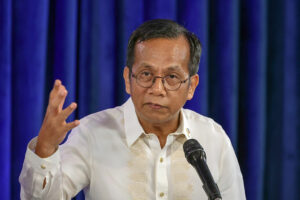THE economy’s expansion in the second quarter may have been “close to” the lower end of the government’s 6-7% target “at least,” driven by solid remittances and employment, the National Economic and Development Authority (NEDA) said.
“I guess that (growth) is probably close to at least the lower end of the target,” NEDA Secretary Arsenio M. Balisacan told reporters on the sidelines of the post-State of the Nation Address (SONA) forum on Tuesday.
“The remittances are quite good. And then the exports have been not as high (because we) also revised upward the export target for goods and services.”
Cash remittances sent back by overseas Filipino workers in May rose 3.6% year on year to $2.58 billion, the fastest pace in five months, the Bangko Sentral ng Pilipinas reported.
Last month, the Development Budget Coordination Committee upgraded its export growth estimate to 5% this year from 3% previously. The value of exports declined 3.1% year on year to $6.33 billion in May, the Philippine Statistics Authority said.
“The employment numbers are okay as you know. So those are good indications. I think the manufacturing output production indicators are coming out above average. This means the sector is expanding,” he added.
The unemployment rate rose slightly to a four-month high of 4.1% from 4% in April, but the measure of quality jobs was the highest since 2005.
Manufacturing activity in June expanded at its slowest pace in three months amid subdued demand, S&P Global said.
During the forum, Mr. Balisacan cited the need to increase investment in agriculture and infrastructure to address food security.
“We have to massively increase our investments and support the agricultural sector to raise the productivity and incomes of our farmers and enable them to become globally competitive. We (also need to) strengthen their ability to meet rising food demand from our growing economy,” Mr. Balisacan said.
The government’s target income from nontax revenue this year is around P100 billion, Finance Secretary Ralph G. Recto told reporters separately. These will come from dividends, Treasury income, fees and charges, and privatization.
He added that funds withdrawn from government-owned and -controlled corporations (GOCCs) could help boost growth by 0.8 percentage points (ppts), helping at least achieve 6% economic growth this year.
“In the DoF’s analysis, (idle funds) will help grow our economy by more or less 0.8 ppts. This (makes it) easier for us to achieve the 6% or maybe 6.5% growth rate this year,” Mr. Recto said during the post-SONA forum.
This would help create over 600,000 jobs, he said.
Mr. Recto also said the fund transfers are legal, as per consultation with the Commission on Audit, the Governance Commission for GOCCs, and the Office of the Government Corporate Counsel.
“In the 2024 budget, Congress said that the DoF should issue a circular to use these funds that are possibly hibernating or sleeping, and are not being used by GOCCs,” Mr. Recto said.
In Circular 003-2024, the DoF had asked the Philippine Health Insurance Corp. (PhilHealth) to remit unutilized funds worth P89.9 billion to the Treasury.
The Bureau of the Treasury reported that PhilHealth and the Philippine Deposit Insurance Corp. (PDIC) remitted P20 billion and 30 billion in dividends in May, respectively.
Excluding the P89.9 billion, Mr. Recto said PhilHealth has unutilized funds amounting to P500 billion, while the PDIC has P350 billion.
Mr. Recto also allayed concerns that the withdrawal of the funds may worsen the deficit.
Budget analysts flagged the government’s fund transfer order, noting that it may compromise GOCCs’ delivery of vital services. — Beatriz Marie D. Cruz
